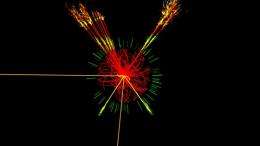Evidence found for the Higgs boson direct decay into fermions

For the first time, researchers at CERN have found evidence for the direct decay of the Higgs boson into fermions—another strong indication that the particle discovered in 2012 behaves in the way the standard model of particle physics predicts. Researchers from the University of Zurich made a significant contribution to the study published in Nature Physics.
For the first time, scientists from the CMS experiment on the Large Hadron Collider (LHC) at CERN have succeeded in finding evidence for the direct decay of the Higgs boson into fermions. Previously, the Higgs particle could only be detected through its decay into bosons. "This is a major step forwards," explains Professor Vincenzo Chiochia from the University of Zurich's Physics Institute, whose group was involved in analyzing the data. "We now know that the Higgs particle can decay into both bosons and fermions, which means we can exclude certain theories predicting that the Higgs particle does not couple to fermions." As a group of elementary particles, fermions form the matter while bosons act as force carriers between fermions.
According to the standard model of particle physics, the interaction strength between the fermions and the Higgs field must be proportional to their mass. "This prediction was confirmed," says Chiochia; "a strong indication that the particle discovered in 2012 actually behaves like the Higgs particle proposed in the theory."
Combined data analysis
The researchers analyzed the data gathered at the LHC between 2011 and 2012, combining the Higgs decays into bottom quarks and tau leptons, both of which belong to the fermion particle group. The results reveal that an accumulation of these decays comes about at a Higgs particle mass near 125 gigaelectron volts (GeV) and with a significance of 3.8 sigma. This means that the probability of the background alone fluctuating up by this amount or more is about one in 14,000. In particle physics, a discovery is deemed confirmed from a significance of five sigma.
Measuring the Higgs decay modes
Three different processes were studied, whereby the UZH researchers analyzed the Higgs decay into taus. Because the Higgs particle is extremely short-lived, it cannot be detected directly, but rather only via its decay products. The bottom quarks and taus, however, have a long enough lifetime to be measured directly in the CMS experiment's pixel detector.
More information: Paper: Evidence for the direct decay of the 125 GeV Higgs boson to fermions, Nature Physics DOI: 10.1038/nphys3005
Journal information: Nature Physics
Provided by University of Zurich



















